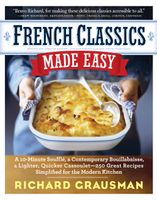Soups
Published 2011
FORMAL DINING, in years past, always included a soup. It came before the first course, and in general it was a cream soup for lunch and consommé for dinner. This style of dining has all but disappeared (although you can still experience it in some of the fine resort hotels of Europe). I generally use soup as a first course or, when served with bread, salad, and a dessert, as a main course—especially hearty soups such as Mediterranean Fish Soup or Split-Pea Soup.
Although the generic term for soups in French cooking is potages, the classic breakdown of types and terms is far more complex. Simply speaking, soups can be divided into two groups: clear soups (or consommés) and thickened soups. Thickened soups are classically further divided into purées, veloutés, and crèmes, and each follows certain rules. Purées are thickened with a purée of a starchy vegetable or grain (such as potato or rice) or a legume (such as lima bean, lentil, or pea). Veloutés are thickened with a light velouté sauce (a white sauce made with stock), while crèmes are thickened with a light béchamel (a white sauce made with milk). Veloutés are enriched, just before serving, with a liaison of egg yolks and butter, and crèmes are finished with heavy cream.
Get instant online access via ckbk
Access this title via ckbk for one-off payment of the eBook price
ckbk includes hundreds of the world's best cookbooks
150,000+ recipes, with thousands more added each month
Powerful search filters to match your tastes
Create collections and add reviews or private notes to any recipe
Swipe to browse each cookbook from cover-to-cover
This à la carte title is available to ckbk members for a one-off payment of
In this section
Part of
Advertisement
Advertisement


